Outdoor Incineration of Livestock Carcasses
In assessing the reported cremation of huge numbers of human corpses in German concentration, labor, transit and/or extermination camps during the Second World War, the capacities of the respective facilities – crematories, outdoor cremation pits and pyres, as well as mass graves – are an important factor. Literature on the pertinent crematories is plentiful and technically well documented, especially by Pressac’s and Mattogno’s works. In particular the Auschwitz camp was well equipped with crematoria. The other camps established in eastern Poland (Treblinka, Sobibór and Belzec) did not have such sophisticated facilities, so that many corpses had to be burned outdoors. Some two million Holocaust victim deaths are traditionally ascribed to these camps. Using current knowledge about the open-air cremation of large amounts of livestock carcasses, the author of the present study investigates under which circumstances the disposal of so many human corpses would have been feasible, if at all.
1. Reports on Corpse Cremations in German World War II Camps
In his work Belzec, Sobibor, Treblinka Yitzak Arad explains that the victims in these camps were killed in homicidal gas chambers using carbon monoxide gas from engine exhaust between fall 1942 and early 1943. Most were initially buried in mass graves. Due to the threat of ground water contamination but also concerns about a possible later discovery of this evidence of mass murder, these corpses are said to have been disinterred in the first half of 1943 and burned over a period of several months.
Apart from impressive descriptions of these fires regarding their blazing flames, intense heat, acrid smoke and unbearable stench, little precise data can be found about them. Some witnesses stated that even living people died in these fires, either because they were forced to jump into them or because loads of victims were dumped into them from trucks. This is not very credible, though, as such huge fires would have been dangerous even for the perpetrators and for any vehicle getting too close to them.
In the above-mentioned book Yitzak Arad describes these open-air incinerations at Treblinka and Belzec as follows:
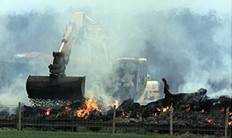

[All photos taken from www.whale.to/m/fmd70.html]
[Treblinka:] The cremation structure consisted of a roaster made from five or six railroad rails laid on top of three rows of concrete pillars each 70 cm high. The facility was 30 m wide.[…].
[…] SS Oberscharführer Heinrich Matthes, the commander of the “extermination area” in Treblinka, testified:
[…] The corpses were piled on these rails. Brushwood was put under the rails. The wood was doused with petrol. (p. 174)
[…] another special team, called the “burning group” (Feuerkolonne), removed the corpses from the stretchers and arranged them in layers on the roaster to a height of 2 meters. Between 2,000 and 2,500 bodies – sometimes up to 3,000 – would be piled on the roaster. When all was ready, dry wood and branches, which had been laid under the roaster, were ignited. The entire construction, with the bodies, was quickly engulfed in fire. The railings would glow from the heat, and the flames would reach a height of up to 10 meters.
At first an inflammable liquid was poured onto the bodies to help them burn, but later this was considered unnecessary; the SS men in charge of the cremation became convinced that the corpses burned well enough without extra fuel.
Yechiel Reichman, a member of the “burning group,” writes:
The SS “expert” on bodyburning ordered us to put women, particularly fat women, on the first layer on the grill, face down. The second layer could consist of whatever was brought […]. Then the “expert” ordered us to lay dry branches under the grill and to light them. Within a few minutes the fire would take so it was difficult to approach the crematorium from as far as 50 meters away. (p. 175)
The body-burning went on day and night. The corpses were transferred and arranged on the roasters during the day; at nightfall they were lit, and they burned throughout the night. When the fire went out, there were only skeletons or scattered bones on the roasters, and piles of ashes underneath. (p. 176)
In Belzec, all 600,000 victims had been buried already when the cremation started. During a period of four to five months they had to be unearthed and burned. (p. 177)
At Belzec and Treblinka, […] a system had to be found to cremate 150,000 to 200,000 corpses within one month and 5,000 to 7,000 in one day. By […] operating simply built, huge, open-spaced crematoria, […] the Operation Reinhard staff was able to complete its mission of cremation and the erasure of their despicable crimes. (p. 178)
Arad’s book contains some information about the size and layout of these camps, and even though these data do not fully agree with other sources, it gives an impression of the surface areas available for the respective “zones of death” for the claimed extermination facilities, mass graves and subsequent incinerations:
| Camp | Size of “Death Zone” | Surface Area | Arad’s Data |
|---|---|---|---|
| Belzec: | 275 m × 90 m | ≈ 24,750 m² (6.1 acres) | map (p. 437) in conj. with total size of camp (p. 27: ca. 275 m × 275 m) |
| Treblinka: | 250 m × 200 m | ≈ 50,000 m² (12.4 acres) | p. 41* |
| Sobibór: | 150 m × 100 m | ≈ 15,000 m² (3.7 acres) | map (p. 35) in conj. with total size of camp (p. 30: 600 m × 400 m) |
| *An official Polish source based on a 1945 survey of the camp claims a surface area of merely 14,000 m² (3.45 acres) for the Treblinka “death zone,” see Graf/Mattogno, pp. 91, 321 | |||
According to eyewitness claims, thousands of bodies, some of them even frozen, were incinerated within a day with a minimal amount of fuel on pyres, which according to Arad had a surface area of 1,000 m² (Treblinka) and 1,500 m² (Belzec and Sobibór). At the end of this process, only ashes and small bone fragments are said to have been left behind. The latter could easily be crushed to dust with stampers. As incredible as such claims may sound, they have been considered to be true so far and were accepted as evidence by various courts of laws.
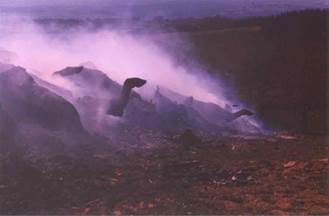
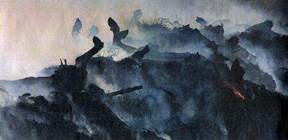
A more recent study of the cremation pyres by M. Tregenza (2000, p. 253) went a step farther. During a German penal trial against former SS guards, witnesses testified that the pyres used in the Belzec camp measured 5 m × 5 m and that up to five of them existed, although the defendants insisted that two of them had existed. Tregenza extrapolated the information about the death toll hitherto attributed to this camp and stated:
There is much disagreement on the subject of the number of pyres at Belzec. Witnesses from the village state that up to five pyres were in use, whereas SS personnel spoke of two pyres during the judicial proceedings in Munich in 1963/1964. According to their indications, at least 500,000 people were burned on those pyres. Assuming that a minimum of 500,000 corpses were burned on two pyres, one has to assume, for five pyres, a much higher figure – possibly twice as high – than the 600,000 persons officially assumed so far.
Such calculations merely highlight how shaky the evidentiary basis is to this very day. Tregenza’s uncritical acceptance of the size of these pyres is interesting, though, as it demonstrates how little he knows about the problems of cremating corpses, or cares about the factuality of these testimonies.
2. Cremating Animal Cadavers during the 2001 Hoof-and-Mouth Epidemic
During the year 2001 Europe and in particular Great Britain were afflicted by a major outbreak of hoof-and-mouth disease. This permits us to investigate in more detail the challenge of incinerating large amounts of human corpses outdoors, since the media gave this process considerable coverage. The various reports of carcass incineration by government authorities give us detailed information as to the procedures used, in particular regarding the amount of fuel needed, the size of the pyres, the duration of the incineration, and also the manpower and man-hours needed as well as the time it took to set up the pyres, etc.
The table at the end of this paper lists the information gathered from various newspaper articles reporting on eight actual events (some of which were mentioned by several sources) as well as two typical instruction manuals. Although these sources all relate to the incineration of animal carcasses – cattle, pigs, sheep – they can be extended to human corpses, since their consistency is very similar regarding the amount of fat, protein and water they contain. The instruction manuals quoted moreover expressly support their application to other animal species (not including humans).
An analysis of the data listed in the below table yields the following results:
2.1. Type and Amount of Fuel
All pyres are basically very similar regarding the fuels used. Coal is the main type of fuel, but since large wooden logs like railway sleepers are an essential element for constructing a pyre, they contribute a considerable amount of energy. Other types of fuels are also used, as for instance wooden skids, tires, straw bales soaked with diesel oil (to start the blaze), and finally at times thermite to ignite the fire.
Veterinary instructions indicate that processes for different species of livestock can be converted one to another for the purpose of calculating the required size of a cremation pyre. According to this, one cattle carcass corresponds to either four pigs, four shorn or three unshorn sheep. When converting the energy contents of each type of fuel into equivalents of wood, the various sources yield between 125 and 875 kg of dry wood per pig-equivalent, with an average of 310 kg. Considering the large variation of the data, it seems advisable to exclude the two extreme values, which yields a corrected average of some 270 kg of dry wood per pig-equivalent.
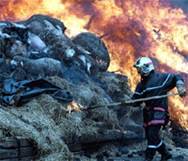
If looking at human corpses in this manner, it is possible to make the conservative estimate that two human bodies correspond to one pig carcass, or eight human bodies to one cattle carcass. This yields an average required amount of some 135 kg of dry wood for the incineration of one human corpse. Depending on the type of wood, this corresponds to 0.2 to 0.3 solid cubic meters of dry (!) wood.
2.2. Design of the Pyres
The sources agree that – at a given load – a narrow but long pyre is preferred to one of a more square shape. That seems obvious, as feeding the pyre with air is essential for an efficient, i.e. hot and swift, cremation. The longer the distance from the edge to the center of the pyre, the higher the risk that the burning mass located there cannot burn efficiently, merely sinking down and smoldering rather than burning. Moreover, in case of need it is exceedingly difficult to add additional fuel to spots more distant from the edge of the pyre.
The sources state in general that pyres should not be wider than some 2.5 m, which is the length of railway sleepers. This size is also conducive to constructing and loading such pyres from the long edges, as the workers can work simultaneously from both sides of the pyre. Photographs and schematic drawings show that cattle are usually placed in a single layer upon the bed of fuel, while sheep and pigs can be loaded in several layers. The total height does not exceed some 1.8 to 2 m, though. If loading is done manually, it is impossible to work at higher heights anyway. If stacked higher, the risk that the pile topples over increases considerably, for instance in case the pyre burns down unevenly or in case any frozen ground melts and thus gives way unevenly. This results in a trapezoidal cross section of the pyre with an area of some 3 to 4 m² and a volume respectively of some 3 to 4 m³ for each meter of the pyre.
If the location does not allow the construction of a single long pyre, it is of course possible to build several pyres next to each other. In that case a minimum distance between individual pyres needs to be kept for safety reasons, in particular if the pyres are not lit at the same time, in which case they are each at different stages of being prepared, burning down or being cleared out. For the pyres used during the 2001 outbreak of hoof-and-mouth disease, a minimum distance of 250 m between pyres was recommended. One witness mentioned a distance of 50 m around the pyres which was too hot and/or smoky to enter (Arad, p. 175). The same is also true for other artificial or natural blazes like burning houses or forest fires.
Based upon the data from the 2001 hoof-and-mouth epidemic it can be calculated that, in case of a single pyre of 1,000 m length and 250 m safety distance around it, an area of 500 m × 1,000 m would be required, plus a safety zone at both ends of the pyre (2 semi-circles of 250 m radius), which amounts to a little more than 50 hectares (124 acres). If that pyre were to be split up into four of 250 m length each, this number would increase to almost 100 hectares (1 km² or 0.4 square mile).
2.3 Duration of the Incineration
The sources quoted give different values for the time it takes for a pyre to burn down completely, ranging from “at least 24 hours” to “one to two weeks.” The shorter times probably refer to the dying down of perceptible flames, the longer values to the time it takes for the pyres to cool down.
2.4 Labor Effort and Other Considerations
The report about the incineration of 800 sheep in France by 100 soldiers deployed for this task also mentions a fleet of trucks (and presumably other equipment) used during the event.
3. The Cremation of Bodies Outdoors in German Wartime Camps in the Light of These Data
The disposal of corpses in German wartime camps was different than the combustion of livestock carcasses in several regards:
- The human corpses had to be almost completely reduced to ashes so that no identifiable remnants would be left behind. The literature on this topic states that any bone fragments left over were even manually ground to powder. This would have been possible only after the pyres had cooled down sufficiently.
- Judging by the witness testimony available, it may be assumed that mainly wood rather than coal was used for the fires, since moderately sized pieces of wood can be transported by hand, whereas the transportation of coal or coke requires at least a modicum of mechanical devices (shovels, wheelbarrows etc.) never referred to in any witness account.
- Since wood has a much lower energy value per unit of mass than coal and coke, and also has a much lower density, such wood-fired pyres are inexorably more voluminous than those made mainly of coal/coke; this means that fewer corpses per surface area can be loaded onto wood pyres than onto coal/coke pyres.
- Wood fires generally burn at lower temperatures than coal/coke fires, which makes it more difficult to reduce corpses completely to ashes this way.
- It may be surmised that any firewood used stemmed from freshly-logged wood taken from surrounding forests. Since green, moist wood has only roughly half the net caloric yield of dried wood, this would double the amount of wood needed, lengthen the time the pyres burned, and reduce even more the average temperature of such pyres, hence complicating the entire process.
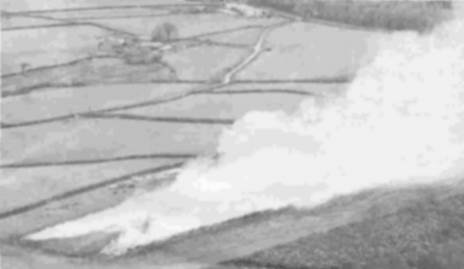
Based upon the above elaboration it can be deduced that the cremation of a human corpse outdoors requires at least 0.2 to 0.3 solid cubic meters of dry wood (or 0.4 to 0.6 solid cubic meters of fresh wood). Together with the corpse itself and the gaps required for an efficient cremation, a typical pyre could maybe accommodate two corpses per cubic meter of pyre for dry wood (and one for fresh wood). The optimally designed pyre for small livestock carcasses as discussed earlier could thus be loaded with some 8 to 10 human corpses per running meter (or 4 to 5 for a sub-optimal pyre using fresh wood). In practice the conditions were most certainly not ideal, meaning that the actual pyres could probably accommodate less than that.
To achieve a daily capacity of some 5,000 to 7,000 corpses, as had to be cremated in those camps if we follow the traditional narrative, dry-wood pyres of 2.5 m width would have been required which were at least some 500 to 700 m long (or 1,000 to 1,400 m in case of moist wood).
After the pyres were ignited, they would have burned for between one and two days, as was reported for the pyres of the 2001 hoof-and-mouth epidemic. Experience with large piles of hot ashes shows that such piles remain hot for numerous days up to a week after the fire was started. After this the piles had to be sifted in search of larger bone fragments in order to grind them down, which would have required probably more than a day. It is therefore realistic to assume that each load of a pyre was being processed for up to ten days before a new pyre could be erected for a new load of corpses.
For the cremation capacity mentioned or implied in the literature of up to 7,000 bodies, ten outdoor cremation sites of the above size had to exist at the same time – all in various stages of the process. If assuming a distance of only 100 m between each such site and around the periphery of all pyres, the total surface area needed for that kind of operation of some 1,000 m × 1,000 m results for dry wood (and twice that for fresh wood). Such a surface area exceeds by far the sizes described in the literature of these camps; and in fact, it exceeds by far the size of every one of these camps taken in their entireties.
The availability of fuel is of course indispensable. The traditional literature does not even raise that issue, let alone discuss it. As a matter of fact, it is claimed that very little if any fuel was required. Assuming that dry wood was the main fuel, we arrive at a requirement of 1,400 to 2,100 solid cubic meters of wood (dry and sawn) which had to be delivered into the camp every day for cremating 7,000 corpses daily. That corresponds to 200 truckloads or 70 to 100 mid-size freight cars via railway, and this every single day for several months. Considering the unreliable transport situation during the war, it would have been advisable to have a minimum reserve of two to three days’ supplies, which means to store some 3,000 to 6,000 solid cubic meters of wood. If logs 2.5 m long are piled up 3 m high, the resulting wood pile would be 400 to 800 m long, and the surface area required would amount to some 1,000 to 2,000 m² – plus additional space to access the piles, many meters wide on either side of the piles. This easily amounts to another hectare (2.5 acres) of surface area. This area alone amounts to a considerable portion of the area which Arad describes as these camps’ “zone of earth” (see above). If, however, freshly-logged wood was used instead, the numbers would again double. In that case, logging that many tress, transporting them into the camp, and cutting them up would pose its own logistic challenge, which shall not be investigated here in detail.
Concerning the labor effort required for the cremations themselves we may assume due to the shortage of labor during the war that mainly forced labor (slave labor) was resorted to and that assisting mechanical devices were hardly available. The excavator depicted in Arad’s book, which is said to have been inoperable at times, could not have done more than lift the corpses out of the mass graves and put them at the workers’ feet.
In the present paper it is not possible to thoroughly describe the workflow, but one needs to keep in mind that the vast area needed for these cremations (if it was available to begin with) would have required that the workers had to travel long distances to bring corpses from the mass graves and fuel from the wood storage area to the pyres – distances of up to a kilometer and more each way are realistic.
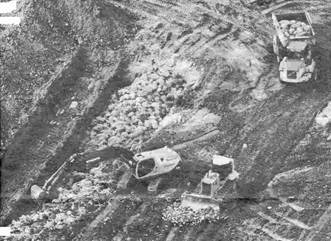
The orthodox literature mentions in passing that a narrow-gauge railway had been constructed. Due to the described ideal design of the pyres, this is not a practical solution, though, because the railway spur would have to run close to the pyre and would have to be relocated to another cremation pyre once one pyre was ready to be set ablaze and the work crew moved to the next cremation site – plus it would have to be a double-track line. It would have been impossible to place the tracks near a burning pyre, because the heat would have compromised both rails and sleepers. It is worth noting that rolling stock would have been almost indispensable for the transportation of 7,000 corpses and 1,400 to 2,100 metric tons of dry wood (or 2,800 to 4,200 tons of green wood) every single day.
4. Conclusions
The statements about the extermination camps made in the orthodox literature contradict the insights gained in connection with the 2001 outbreak of hoof-and-mouth disease to such a degree that it is impossible to accept the claims of the orthodox literature, according to which for several months thousands of human corpses were cremated every day within the confines of the Treblinka, Sobibór and Belzec camps. These camps probably had facilities permitting the cremation of corpses, but most likely on a much smaller scale than claimed. A generous calculation using the surface areas actually available according to the orthodox literature (1,000 to 1,500 m² for each camp) results in pyres of a size permitting the cremation of maybe some 1,500 corpses per week, but not several tens of thousands, as is usually claimed.
If following the data given by M. Tregenza for the claimed pyres (4, possibly 5 “grills”, each of 5 m × 5 m, i.e. some 100 to 125 m²), the estimates shrink even further by almost an order of magnitude to several hundred corpses which could have been disposed of within a week. In any case, the claims that fuel wood was needed only to start the fires are outside of the realm of documented experiences and must therefore be rejected. All reports about actual pyres during the 2001 hoof-and-mouth epidemic as well as instructions for the construction of such pyres emphasize the substantial fuel requirement.
This paper does not conclude that no such cremations took place at all in these camps. Crimes against humanity do not depend on a set number of victims. Legal and moral decisions follow different guidelines than technical issues. But we should reconcile ourselves to the thought that the two million victims attributed to these camps are a gross exaggeration. Considering the verifiable information about these camps and the experiences with outdoor mass cremations during livestock epidemics, we can safely assume that not more than 3,000 to 5,000 corpses could have been disposed of weekly. Applying this to the total time span during which such cremations are said to have occurred in the context of the “Aktion Reinhardt,” that is to say a four- to six-month period, no more than 80,000 to 125,000 corpses could possibly have been disposed of in that manner. The actual numbers are likely to be much lower than these, though.
| Description of actual outdoor mass cremations and of livestock and instructions to construct pertinent pyres | |||||||||||
|---|---|---|---|---|---|---|---|---|---|---|---|
| reference # | [1] | [2] | [3] | [4] | [5] | [6] | [7] | [8] | [9] | [9a] | [10] |
| location/authority | Heddon-on-the-Wall | Caldbeck | Shadwick | Burdon | Epynt | Oswestry | Oswestry | FAO | DOH | APHIS | Bondues, France |
| cattle | 75 | 500 | 401 | 200 | 300 | 68 | 45 cows, 10 calves | 1 | 1 | 1 | |
| pigs | 850 | 450 | or 4 | or 5 | |||||||
| sheep | 730 | 115 | 90 | or 4 shorn or 3 unshorn |
or 5 | 818 | |||||
| pig-equivalents | 1150 | 2000 | 1604 | 1770 | 1200 | 860 | 320 | 4 | (4) | 5 | 1100 |
| railway sleepers | 250 | 3800 | 700 | 800 | 380 | 200 | 150 | 1 | 3 | 3×8 sq ft | 350 |
| coal [t] | 75 | 700 | 200 | 290 | 175 | 30 | 25 | 0.2 | 1 | 0.23 | 60 |
| wood | 900 skids | 29 t | 250 skids | 4 truckloads 200 tires | 2 truckloads 100 tires | 35 kg | 40 kg | 23 kg | 56 m³ | ||
| diesel oil [l] | 7600 | 3000 | 2800 | 150 | 150 | 5 | 3.8 | (60 t?) | |||
| straw | 2 truckloads | 60 t | 20 t | 4 t | 350 bales | 250 bales | 1 bale | 1 bale | 3 bales | 10 t | |
| length [m] | 150 | 250?350? | 250?500? | 60 | 45 | 0.9/cattle | 100 | ||||
| wood equivalents [t] | 185 | 1750 | 450 | 677 | 400 | 110 | 75 | 0.5 | 2.3 | 0.87 | 190 |
| wood/pig [kg] | 160 | 280 | 360 | 330 | 130 | 235 | 575 | 174 | 170 | ||
| wood/pig [kg] | average: 310 kg; corr. average: 270 kg (values struck through not considered) | ||||||||||
| For this study the caloric value of each type of fuel is expressed as wood equivalents. Some basic value can be found here: http://www.brennholz-killat.de/abc/Heizwerttabelle.pdf, from which I took “Heizöl EL” for diesel, “Brennholz (Mittel)” for average wood, “Steinkohle” for coal, “Stroh (in Ballen)” for bales of straw with 0.25 m³ and 35kg per bale. Considering the frequent imprecision of the data given (skids, truckloads etc.) some calculations had to be based on educated guesses. However, in every case the contribution of coal and wood was always the decisive value. Unless indicated otherwise, a railway sleeper was calculated as a piece of wood of 2.5 m × 0.3 m × 0.2 m with a specific density of 0.5 t/m³. | |||||||||||
5. Recommended Reading
Revisionists have dealt with the above problem in a number of their books. The results are similar to the present study, although the ways the authors arrived at them are much more complex. The present study has the advantage that it is based on real, properly documented cases of open-air mass cremations which are similar in style, scope and scale to the ones claimed for the alleged extermination camps of “Aktion Reinhardt.” The so-inclined reader may compare the present result to those obtained in these studies, of which the first three are concise while the last one is exhaustive to the point of being excessive:
- Jürgen Graf, Thomas Kues, Carlo Mattogno, Sobibór: Holocaust Propaganda and Reality, The Barnes Review, Washington, DC, 2010, pp. 130-148
- Carlo Mattogno, Belzec in Propaganda, Testimonies, Archeological Research, and History, Theses & Dissertations Press, Chicago, IL, 2004, pp. 82-87.
- Carlo Mattogno, Jürgen Graf, Treblinka: Extermination Camp or Transit Camp?, reprint of 2nd ed., The Barnes Review, Washington, D.C., 2010, pp. 145-152
- Carlo Mattogno, Thomas Kues, Jürgen Graf, The “Extermination Camps” of “Aktion Reinhardt”: An Analysis and Refutation of Factitious “Evidence,” Deceptions and Flawed Argumentation of the “Holocaust Controversies” Bloggers, Castle Hill Publishers, Uckfield, UK, October 2013, vol. 2, pp. 1169-1332. [Editor’s remark: more recent:
Carlo Mattogno, The “Operation Reinhardt” Camps Treblinka, Sobibór, Bełżec: Black Propaganda, Archeological Research, Expected Material Evidence, Uckfield: Castle Hill Publishers, 2021
Literature
- Yitzak Arad, Belzec, Sobibor, Treblinka, Indiana University Press, Bloomington/Indianapolis, 1999
- Carlo Mattogno, I forni crematori di Auschwitz: Studio storico-tecnico, Effepi, Genoa, 2011 (English: Carlo Mattogno Franco Deana, The Cremation Furnaces of Auschwitz: A Technical and Historical Study, 3 Parts, 2nd ed., Uckfield: Castle Hill Publishers, 2021
- Jean-Claude Pressac, Technique and Operation of the Gas Chambers, Beate Klarsfeld Foundation, New York, 1989
- Jean-Claude Pressac, Die Krematorien von Auschwitz, Piper, Munich, 1994
- Michael Tregenza, “Das vergessene Lager des Holocaust,” in I. Wojak, P. Hayes (eds.), “Arisierung” im Nationalsozialismus: Volksgemeinschaft, Raub und Gedächtnis, Campus, Frankfurt/Main 2000, p. 253
References for Table Columns
| [1] | The Guardian, 26 February 2001; The Times, 26 February 2001; Der Spiegel, SPIEGEL ONLINE – 26 February 2001, 06:53; www.spiegel.de/politik/ausland/0,1518,119729,00.html |
| [2] | The Guardian, 28 April 2001. |
| [3] | The Independent, 19 March 2001. |
| [4] | Financial Times, 5 March 2001, The Times, 2 March 2001. |
| [5] | Current Concerns, P.O. Box 927, CH-8044 Zürich, Archive, 2 January 2002 |
| [6] | Village Tidings, ISSN 1353 2243, c/o Ferryhouse, Bolton Abbey, Skipton, N Yorks, BD23 6HB; e-mail: [email protected], vol. 39, summer 2001 (this pyre, as pyre no. 7, was operated during the hoof-and-mouth epidemic of 1968) |
| [7] | Ibid. |
| [8] | William A. Geering, Mary-Louise Penrith, David Nyakahuma, Manual on procedures for disease eradication by stamping out…, FAO Animal Health Manual No. 12, FAO, Rome 2001;www.fao.org/docrep/004/Y0660E/Y0660E02.htm; last accessed on Dec. 26, 2014; this is almost identical to a French government source of that time: Direction générale de l’alimentation, Sous-direction de la santé et de la protection animales, Bureaux: Santé animale, Note de service DGAL/SDSPA/SDSSA/N2003-8050; Annexe 3: L’incineration des cadavres, Paris, March 10, 2003. |
| [9] | Department of Health, UK, www.doh.gov.uk/fmdguidance/disposalriskassessmentannexes.pdf; last accessed in 2005, now removed. |
| [9a] | Other, newer sources give similar data; see e.g. Curtis Kastner et al., Carcass Disposal: A Comprehensive Review, National Agricultural Biosecurity Center Consortium, Carcass Disposal Working Group, March 2004, Part 1, ch. 2, p. 9; online e.g. at http://amarillo.tamu.edu/files/2011/01/draftreport.pdf; numbers are based on S.N. Smith, R. Southall, T.L. Taylor, APHIS Carcass Disposal Manual, operational guidelines (15th Draft, 2/22/02), United States Department of Agriculture, Animal and Plant Health Inspection Service, Washington, DC, 2002; and C. McDonald, Report to Dumfries and Galloway Council: Air monitoring of carcass pyre at Whithorn. Glasgow, Glasgow Scientific Services, 2001. See also National Animal Health Emergency Management System Guidelines: Operational Guidelines: Disposal, U.S. Department of Agriculture, April 2005, p. 11-13; www.aphis.usda.gov/emergency_response/tools/on-site/htdocs/images/nahems_disposal.pdf |
| [10] | La Voix du Nord, 6 March 2001, “Un bûcher de 100 m de long pour 600 moutons” |
Updated version of the original German paper published as “Leichenverbrennungen im Freien,” in Vierteljahreshefte für freie Geschichtsforschung 8(4) (2004), pp. 427-432; http://www.vho.org/VffG/2004/4/Koechel427-432.html.
Bibliographic information about this document: Inconvenient History, 7(1) 2015; updated version of the original German paper published as “Leichenverbrennungen im Freien,” in Vierteljahreshefte für freie Geschichtsforschung 8(4) (2004), pp. 427-432; http://www.vho.org/VffG/2004/4/Koechel427-432.html.
Other contributors to this document: n/a
Editor’s comments: n/a
